
Draba lactea, the Lapland whitlow-grass or milky whitlow-grass, is a flower common throughout the high Arctic. It stretches further south in mountainous areas of Norway, Montana, Canada, and Greenland.

Tripleurospermum inodorum, common names scentless false mayweed, scentless mayweed, scentless chamomile, wild chamomile, mayweed, false chamomile, and Baldr's brow, is the type species of Tripleurospermum. This plant is native to Eurasia and North Africa, and introduced to North America, where it is commonly found in fields, fallow land and gardens.

Iris giganticaerulea, the giant blue iris, is a species of iris, in the subgenus Limniris, in the series Hexagonae. It is a rhizomatous perennial, from northern America. It has long bright green leaves, very tall stems and one or two musky fragrant flowers in a range of blue shades or rarely white.

Heteranthera limosa is an annual flowering plant in the water hyacinth family known by the common names ducksalad and blue mudplantain. It grows in shallow water or on mud. It is considered a threatened species in parts of the central United States, and an invasive species weed in California, where it is a nuisance in rice paddies. It is also occasional in Florida waterways.

Symphyotrichum laeve is a flowering plant native to Canada, the United States, and Coahuila (Mexico). It has the common names of smooth blue aster, smooth aster, smooth-leaved aster, glaucous Michaelmas-daisy and glaucous aster.

Calycoseris wrightii, commonly known as white tackstem, is an annual spring wildflower, one of two species in the genus Calycoseris; the other species is C. parryi, the Yellow tack-stem. They are part of the sunflower family.
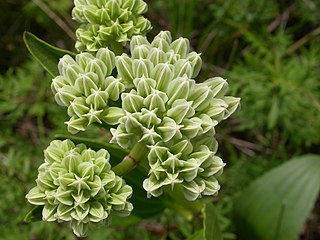
Arnoglossum plantagineum also known as tuberous Indian-plantain, groovestem Indian plantain or Prairie Indian plantain, is a North American species of Arnoglossum in the sunflower family. The Latin specific epithet plantagineum refers to the leaves of the plant which are similar to those of a plantain.
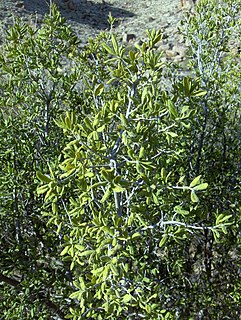
Diospyros texana is a species of persimmon that is native to central, south and west Texas and southwest Oklahoma in the United States, and eastern Chihuahua, Coahuila, Nuevo León, and Tamaulipas in northeastern Mexico. Common names include Texas persimmon, Mexican persimmon and the more ambiguous "black persimmon". It is known in Spanish as chapote, chapote manzano, or chapote prieto, all of which are derived from the Nahuatl word tzapotl. That word also refers to several other fruit-bearing trees.
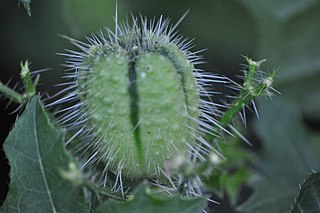
Cnidoscolus texanus, commonly known as Texas bullnettle, tread-softly, mala mujer, and finger rot, is a perennial herb covered with stinging hairs. The main stem, branches, leaves, and seed pods are all covered with hispid or glass-like bristly hairs that release an allergenic toxin upon contact. Contact with the plant results in intense pain: stinging, burning, and itching lasting for hours. It is native to the U.S. states of Texas, Arkansas, Kansas, Louisiana, and Oklahoma and also native to the northeastern state of Tamaulipas, Mexico. It is an herbaceous flowering plant that grows between 30–80 cm (11.8–31.5 in) tall and as much as 1 m (3.3 ft) across. Texas bullnettle has showy, fragrant white flowers that can bloom throughout the year in southern regions of its distribution, predominantly March to November in northern regions. It is a drought-tolerant plant, therefore making it a superb choice for xeriscaping. This plant is attractive to birds, bees, butterflies, and other insects. The seeds are known to be consumed by Rio Grande wild turkeys and mourning doves.
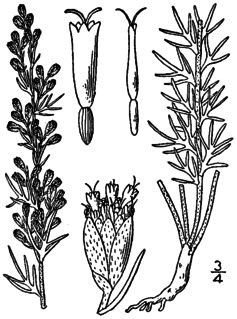
Artemisia carruthii, common name Carruth's sagewort or Carruth wormwood, is a North American species of shrubs in the daisy family native to much of south-central and southwestern United States. There are reports of a few naturalized populations in Missouri, the Great Lakes Region, and Rhode Island. It is also native to the States of Chihuahua and Sonora in northern Mexico.

Helianthus decapetalus, known by the common names thinleaf sunflower and thin-leaved sunflower, is a perennial forb in the family Asteraceae. It is native to the Eastern and Central United States and Canada, from New Brunswick west to Iowa, Wisconsin, and Ontario, south as far as Georgia and Louisiana. It produces yellow composite flowers in late summer or early fall.
Calochortus westonii, common name Shirley Meadow star-tulip, is a rare endemic plant known only from the Greenhorn Mountains range of the southern Sierra Nevada, within Kern and Tulare Counties, California.
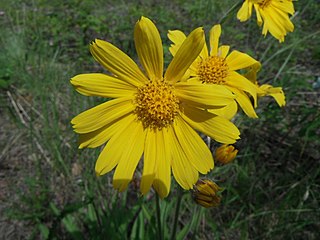
Arnica lonchophylla is a species of flowering plant in family Asteraceae. The common names for this species includes longleaf arnica, northern arnica, and spear-leaved arnica. It has daisy-like yellow flowers that are 2.5 to 5 cm across with a yellow center disks.

Bradburia pilosa, the soft goldenaster, is a North American species of flowering plants in the family Asteraceae, native to the south-central United States, primarily the southeastern Great Plains and lower Mississippi Valley, in the states of Texas, Oklahoma, Kansas, Missouri, Arkansas, Louisiana, Tennessee, Mississippi, and Alabama. Additional populations are reported farther east but these appear to be introductions. Its habitats include disturbed roadsides and pine-oak-juniper woods.
Lactuca ludoviciana, the biannual lettuce, is a North American species of wild lettuce. It is widespread across much of central and western Canada and the western and central United States from Ontario west to British Columbia and south to Louisiana, Texas, and California. Most of the known populations are on the Great Plains; populations west of there may well represent naturalizations.
Hymenopappus flavescens, the collegeflower, is a North American species of flowering plant in the daisy family.

Carya pallida, sand hickory, or pale hickory is a species of hickory native to the southeastern United States. It is a perennial, dicotyledonous plant which prefers rocky or sandy habitats. The sand hickory can reach heights of up to 30m, but its typical height is between 9-24m. In an open area, Carya crowns are usually towering and slim. The sand hickory nut is edible and consumed by various organisms.
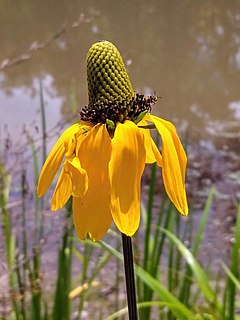
Rudbeckia texana, commonly known at Texas coneflower or shiny coneflower, is a perennial plant in the family Asteraceae native to the Western Gulf coastal grasslands of Texas and Louisiana.

Rumex fueginus, known as American dock, golden dock, and Tierra del Fuego dock, is a flowering plant in the family Polygonaceae. Rumex fueginus was first formally named by Rodolfo Armando Phillipi. Rumex fueginus is native from Canada in northern North America to Tierra del Fuego at the southern tip of South America. It has previously been considered a subspecies or variety of Rumex maritimus, a Eurasian species.

Nymphaea tetragona is a species of flowering plant commonly called pigmy waterlily and small white water lily, belonging to the family Nymphaeaceae. In North America and Europe it native range is restricted to the boreal regions above 50° N latitude.

















